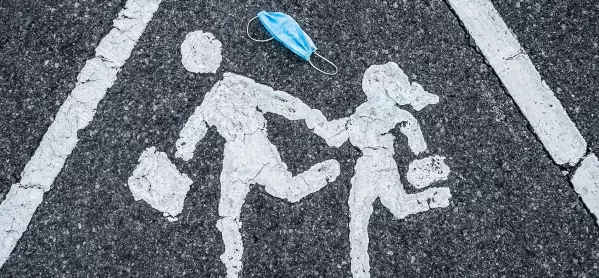Covid: Teachers needed more evidence for masks

Teachers facing difficulty in enforcing the wearing of masks during the height of the Covid pandemic would have benefited from having more evidence showing they were slowing the spread of the virus, a report has found.
New analysis published by the Department for Education today said that older pupils were more likely to question the efficacy of face coverings, and that teachers often needed to convince parents.
The DfE has published new research into the use of face coverings in schools and an updated analysis of the impact on Covid-19 absence rates.
This includes data showing that, last year, a group of schools that had requested face coverings be worn saw a slower rise in Covid absence than a group of schools that had not.
- Omicron: Masks back as government battles latest Covid wave
- Background: Face coverings returned in communal areas
- More: School staff more likely to catch Covid than other workers
The analysis compared Covid absence rates in September and October of last year.
After weighting two groups, initial weekly Covid absence rates were the same in both at 1.4 per cent for the week starting 6 September 2021.
However, six weeks later, schools that reported requesting face coverings be worn saw a lower increase in weekly Covid-19 absences - reaching 2.9 per cent rather than 3.5 per cent.
One of the DfE reports published today has findings from surveys and focus groups that consulted pupils and teachers on the use of masks in school.
It highlighted the challenges schools faced getting masks to be worn in schools.
The report said: “Teachers reported differing levels of difficulty in enforcing face coverings, and many fed back that more evidence to show they were having a positive impact on transmission rates would have been beneficial.
“They told us that older pupils were more likely to question the efficacy of face coverings, and that they often needed to convince parents, as well as pupils. Teachers expressed the view that face coverings only worked if they were used properly, and that was difficult to enforce.
Teachers in the focus groups also reported that face coverings “weren’t necessarily associated with poor wellbeing, but they did make it harder to see who was struggling”.
The DfE report said that teachers told researchers that they tried to make sure the pupils with the most needs were at the front of the classroom, and closest to them, so it was easier to check on how they were getting on.
It was also suggested that wearing face coverings should be strategic, with times that they can be pulled down, for instance when the wearer was near an open window.
Some teachers said that face coverings caused anxiety at the outset of the pandemic, but that pupils had now become used to wearing them and that anxiety had dissipated. Others said face coverings were exacerbating skin complaints.
Pupils’ view
The report also includes the perspective of pupils.
It says it was clear from pupils in the focus groups that “different approaches were taken by different schools throughout the pandemic, and indeed by different teachers within the same school toward face covering enforcement”.
It adds: “Some schools were hard-line, demanding compliance at all times, while other schools appeared to be quite relaxed, possibly ambivalent about students having to wear them. Pupils in the focus groups said they wanted rules on face coverings, once instigated, to be ruthlessly and equitably enforced.”
The recommendation of masks in schools was an intermittent feature of the DfE’s response to the Covid crisis.
Most recently, in January this year, the government recommended that face masks be worn in all secondary classrooms from the start of term in response to the spread of the Omicron variant.
Before this, staff, visitors and students in Year 7 and above had been advised to wear masks in communal areas of school in guidance issued in November 2021.
Face coverings in secondary classrooms were also brought in in March 2021, but stopped being a recommendation just over two months later.
You need a Tes subscription to read this article
Subscribe now to read this article and get other subscriber-only content:
- Unlimited access to all Tes magazine content
- Exclusive subscriber-only stories
- Award-winning email newsletters
Already a subscriber? Log in
You need a subscription to read this article
Subscribe now to read this article and get other subscriber-only content, including:
- Unlimited access to all Tes magazine content
- Exclusive subscriber-only stories
- Award-winning email newsletters



